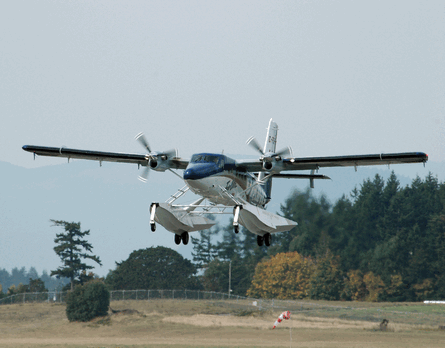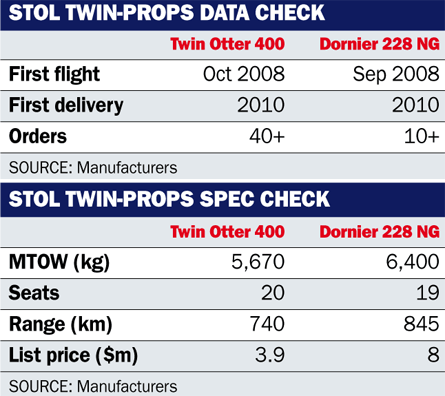Reliability, ruggedness, versatility, economy and excellent short take-off and landingperformance have been the hallmark of two unpressurised turboprops long out of production. But now, the former de Havilland Canada Twin Otter and Germany's Dornier 228 are poised to re-enter production.
A year after taking to the air once more, the latest incarnation of the versatile Twin Otter, the Series 400, is poised to obtain its certification, clearing the way for first customer delivery to Swiss charter company Zimex Aviation, at the beginning of 2010.
Viking Air's technical demonstrator is entering the final stages of ground and flight-testing designed to lead to Transport Canada approval before year-end, with European clearancefollowing soon after.
 |
|---|
© Viking Air |
US Federal Aviation Administration certification will follow a year later because of a lack of orders from across the border. First deliveries were planned for late summer, but technical issues with the Honeywell Primus Apex integrated flightdeck and, specifically, the conversion of data acquisition units from analogue to digital, meant that the planned July certification date has slipped a few months.
In spite of this hiccup, the last few months have strengthened the company's conviction of the programme's viability with a number of new orders which, according to Viking, have brought the current backlog to more than 40 aircraft worth $177 million and pushing the next available delivery to 2012.
Production of 24 aircraft is targeted from then on, primarily to account for attrition. In between orders from the Maldives, New Caledonia, Russia and Libya, Global Aerospace Logistics of Abu Dhabi signed a purchase agreement at June's Paris air show for 10 Twin Otters, which represents the largest order for the type to date. With options, the total order package could exceed $65 million.
HARDY EVOLUTION
Apart from six landplane-configured aircraft, the purchase agreement also includes the first success for the newly offered Guardian 400 maritime patrol, SAR and critical infrastructure and surveillance aircraft.
The Guardian 400, with four crew observation stations, will include a restricted category increased take-off weight, and extended range internal patrol tank, enabling operational sorties of more than 10h duration.
Other available options include spotter camera, laser range finder and a laser illuminator, as well as a 360e_SDgr digital colour radar system with track-while-scan capability, rescue equipment drop hatch, and four wing hard points for additional stores. A galley with adjacent lavatory ensures crew comfort.
According to the company, the new Series 400 features more than 200 modifications and improvements to the original design, with a focus on reducing empty weight and operational and maintenance costs, while enhancing the aircraft's reliability.
The principal changes made to the aircraft are higher output Pratt & Whitney Canada PT6A-34 turboprop engines, with the PT6A-35 hot and high-performance variant with four-blade propeller available as an alternative, and a new Honeywell Primus Epic integrated avionics suite.
With many of the 600 or so aircraft of the original design operating in the harshest conditions, Viking Air has, from the beginning, also focused on corrosion prevention, incorporating an increased number of drains and new preventative compounds.
DORNIER RETURNS
In contrast to the Twin Otter, the revival of the Dornier 228 developed by Ruag Aerospace Services has been a more restrained affair. When Ruag took over the support operation in 2002, there was no intention to relaunch the aircraft, says managing director Wolfgang Neumann, but a new demand in the commuter and special missions market convinced the company to put the 228 back into production.
|
|---|
The limited design changes proposed, combined with a restart cost of less than €10 million ($15 million), appear to make this project viable, although orders for the aircraft have been slow to arrive.
With the most recent contract from Vietnam for two aircraft, the orderbook stands at 10 firm orders and five options. Ruag envisages a market of 60-80 aircraft, with break-even set at less than half that number. Planned production in the start-up phase is up to 10 aircraft a year.
The 228 NG (New Generation) is equipped with upgraded, 775 shp (580kW) Honeywell TPE331-10 engines driving MT-Propeller's five-bladed composite propellers, together with a glass cockpit of Rockwell Collins digital avionics and Universal displays.
It also features improved aerodynamics to the wing, including coupled aileron droop to boost short-field performance. Minor further design changes are being investigated.
The modified 228-212 flew in September 2008. The first shipsetwas delivered by risk-sharing partner Hindustan Aeronautics to Oberpfaffenhofen in April 2009, and a successful "power on" of the glass cockpit was achieved in June. Three aircraft are on the production line, with first delivery to an unnamed Asian launch customer scheduled for January 2010.
Source: Flight International

















